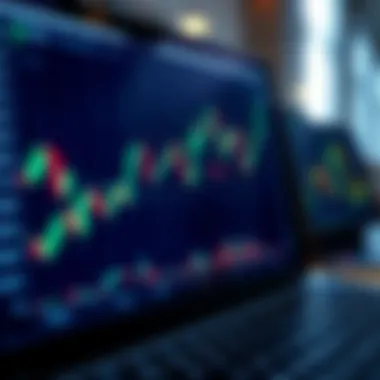Mastering ETF Purchases with Charles Schwab


Intro
Navigating the process of purchasing Exchange-Traded Funds (ETFs) through Charles Schwab has never been more crucial, especially in today's rapidly changing financial landscape. This guide aims to walk you through this adventure, helping you understand not just the mechanics of trading on this platform, but also the underlying concepts of ETFs that are vital for making informed decisions.
Many investors approach the world of ETFs with varying levels of experience and understanding. Whether you’ve never traded a stock in your life or you’re a seasoned trader, Schwab offers tools and resources that can help everyone engage effectively with their investment goals. You’d be surprised to know how much flexibility there is when it comes to building your portfolio, ensuring that you not only meet your financial aspirations but also tailor your investments to your specific risk tolerance.
This article will guide you through the nitty-gritty of purchasing ETFs on Charles Schwab, discussing the platform's functionalities, evaluating your investment goals, and reviewing the various types of accounts you may consider. This ain’t just another run-of-the-mill guide; it’s designed to empower you, enhance your financial literacy, and bring clarity to your investment strategy.
“The best investment you can make is in yourself. The more you learn, the more you earn.” – Warren Buffett
While we delve into the details, remember that investing is a journey requiring patience, research, and a willingness to learn. Let’s chart a course to investment success, shall we?
Understanding Exchange-Traded Funds
Exchange-Traded Funds, or ETFs, have become a cornerstone in the modern investment landscape. Their significance in this guide to navigating the purchase process on Charles Schwab lies not only in their structure but also in the various benefits and risks they carry. As investment vehicles, they offer a blend of stock and mutual fund features, making them appealing to a broad audience. Understanding the fundamentals of ETFs equips investors with the necessary knowledge to make sound decisions when investing.
Definition of ETFs
ETFs are investment funds that are traded on stock exchanges, much like individual stocks. They hold a collection of assets, which can include stocks, bonds, commodities, or a mix thereof. With ETFs, investors gain exposure to a diversified portfolio without needing to purchase all the constituent securities individually. The ability to buy and sell shares throughout the trading day, akin to stocks, distinguishes ETFs from mutual funds, which trade only at the close of business.
Key Characteristics of ETFs
To understand ETFs better, it’s important to recognize their unique characteristics. Here are a few key points:
- Liquidity: ETFs can be traded at any time during market hours, providing flexibility that many investors appreciate.
- Diversification: An ETF can represent a whole sector of the economy, a single country, or an index, reducing the risk associated with individual stocks.
- Cost-Effectiveness: Generally, ETFs come with lower expense ratios compared to traditional mutual funds. This is partly due to passive management strategies that many ETFs employ.
- Transparency: ETFs usually disclose their holdings daily, giving investors insights into what they own.
Benefits of Investing in ETFs
Investing in ETFs presents several advantages that can appeal to different types of investors:
- Flexibility: With the ability to sell short, buy on margin, or execute limit orders, investors have control over how they manage investments.
- Tax Efficiency: ETFs tend to be more tax-efficient than mutual funds because of their unique structure, which minimizes capital gains distributions.
- Accessibility: Schwab and other brokerages typically allow investors to buy ETFs with low or zero commissions, making it easier to start investing with smaller amounts.
- Choice: The vast array of ETFs means that investors can target specific sectors, themes, or investment strategies according to their risk tolerance and goals.
Risks Associated with ETFs
However, it's crucial to approach ETFs with eyes wide open to the risks involved:
- Market Risk: As with any investment, there’s potential for loss due to market fluctuations. Investors must be prepared for volatility.
- Tracking Error: Sometimes, an ETF’s performance does not perfectly match the underlying index it seeks to mimic, leading to discrepancies.
- Liquidity Concerns: While many ETFs are liquid, some niche products may not have ample trading volume, making them harder to sell without impacting the price.
- Fees: Although generally lower than mutual funds, some ETFs may have management fees and other costs that can add up over time.
"Understanding the fundamentals of ETFs is not just wise; it's essential for making informed investment decisions."
In summary, navigating the world of ETFs on Charles Schwab requires a solid grasp of what they are, their characteristics, advantages, and potential pitfalls. Armed with this knowledge, investors can better assess how ETFs fit into their overall investment strategy.
Overview of Charles Schwab
Understanding Charles Schwab is essential when embarking on the journey to invest in ETFs. As a leading financial services firm, Schwab has built a reputation for innovation and excellence in brokerage services. Their platform caters to a wide range of investors, from novices to seasoned professionals, making it a versatile choice for anyone looking to navigate the complexities of the stock market.
Charles Schwab's Reputation in Brokerage Services
Charles Schwab has established itself as a beacon of reliability within the financial services industry. It was founded in 1971, and since then, it has transformed the way individuals approach investing. Schwab is often recognized for its customer-centric approach, prioritizing investor education and transparency. This commitment has garnered a loyal customer base, which trusts the firm to guide them through their investment endeavors. Notably, Schwab was among the pioneers of discount brokerage services, breaking the mold of traditional trading practices. This forward-thinking approach has solidified its status as a leader in the field.
The Schwab Trading Platform
At the heart of investing through Charles Schwab lies its robust trading platform. The platform is designed to be user-friendly while offering powerful tools for those looking to take a deep dive into the intricacies of the market. Investors can easily navigate through various sections, whether they are researching stocks, reviewing their portfolio performance, or executing trades. One notable feature is the integration of comprehensive research and analysis tools, allowing users to make informed decisions.
The platform is equipped with advanced charting functions and real-time market data, ensuring that investors have all the information they need right at their fingertips. Moreover, Schwab continuously updates its technology to enhance user experience, which in turn can lead to better investment outcomes. For those who are tech-savvy or prefer using mobile devices, Schwab’s mobile app offers similar features, allowing for trading anytime and anywhere.
Fees and Commissions Structure
When it comes to investing, understanding fees and commissions is crucial—it can significantly impact overall returns. Charles Schwab has a competitive fee structure that appeals to many investors. Notably, they offer commission-free trading on equities and ETFs, which is a big attraction in today's market landscape. This model allows investors to buy and sell without worrying about incurring hefty transaction costs with every trade they make.
Beyond trading fees, Schwab presents transparency in expense ratios for its funds, which is invaluable when assessing overall investment choices. They also provide low-cost options for mutual funds, further enhancing their appeal to those who wish to invest with minimal fees. Here’s a quick summary:
- Commission-free trades on stocks and ETFs: A major advantage for active traders.
- Transparent expense ratios: Clients can easily access what they are paying for their funds.
- Low-cost mutual funds: Easy on the wallet for long-term investors.
In essence, Charles Schwab not only simplifies the investment process but also ensures investors can focus on growing their portfolios rather than worrying over costs. Ultimately, understanding these facets of Schwab's offerings is foundational for anyone looking to invest in ETFs with confidence.


Setting Up Your Schwab Account
Setting up a Schwab account is akin to laying down your foundation before building a house. This step is crucial, for it unlocks the door to the world of Exchange-Traded Funds (ETFs) and investment opportunities. Whether you're a seasoned investor or someone looking to dip their toes in the investment waters, getting your Schwab account set up correctly is a vital step that can make a big difference down the line.
Types of Accounts Offered
When it comes to investing with Charles Schwab, the types of accounts they offer cater to various needs and goals. Each account serves a unique purpose and is designed to help you manage your investments more effectively.
Individual Brokerage Account
The Individual Brokerage Account is the bread and butter for most investors. This kind of account allows you to buy and sell securities like ETFs, stocks, and mutual funds without many limitations. A key characteristic of this account is its flexibility; it’s suitable for both short-term trading and long-term investing strategies.
One important aspect to consider is how easy it is to access your funds. With an Individual Brokerage Account, you can withdraw cash for personal expenses. This makes it a popular choice among individuals who want to maintain control over their investments while also having the flexibility to access their cash when needed.
The drawback, however, is the tax implications. Since profits can be taxable, it’s imperative to keep track of your gains and losses, which may complicate your tax filing.
Retirement Accounts
Retirement Accounts, such as Traditional and Roth IRAs, have their own charm and appeal, especially for long-term savers looking to prepare for the future. The key characteristic of these accounts is that they offer tax advantages that can either defer or completely eliminate taxes on your investment gains until you withdraw funds in retirement.
The unique feature here is the ability to contribute on a tax-deferred basis. For instance, with a Traditional IRA, you might deduct your contributions from your taxable income, leading to potential tax savings today. This is a beneficial option for many, as it can lead to significant growth over time due to compounding interest.
However, the disadvantage is that there are limits to how much you can contribute each year, and penalties may apply if you withdraw funds before reaching retirement age.
Custodial Accounts
Custodial Accounts are specifically designed for minors. This kind of account allows adults to manage funds on behalf of a child until they reach a certain age, often 18 or 21, depending on state laws. The key characteristic of Custodial Accounts is that they provide a way for parents and guardians to save and invest for their child's future.
An intriguing feature of these accounts is the ability to teach children about investing and financial responsibility while still having parental oversight. It’s often a beneficial choice for families who wish to instill good financial habits early on.
However, a downside is that once the child reaches the designated age, they gain full control of the account, which might lead to them making decisions that parents might not fully agree with.
Documentation Required for Account Opening
To open any type of account at Charles Schwab, you’ll need to prepare specific documentation. Typically, this includes your Social Security number, a valid form of identification, and some statements about your financial background. Without these documents, the process could face unnecessary delays, which could be aggravating no doubt.
Funding Your Schwab Account
Once your Schwab account is set up, the next logical step is funding it so you can start making those investments in ETFs. The methods for funding are straightforward and offer flexibility to cater to your preferences.
Linking Your Bank Account
Linking your bank account to your Schwab account is essential and a fairly simple process. This action allows for direct transfers, making it easy to move your money into your investment account when opportunities arise. The key characteristic here is the quick access you have to funds for investment activities without the middleman.
While convenient, this can pose a risk if you do not monitor your spending. Always ensure that your linked bank account has enough funds to avoid overdrafts when making purchases.
Transferring Assets
If you have investments elsewhere, you might consider transferring those assets over to your Schwab account. This can streamline your investing process, bringing everything under one roof. The key characteristic of transferring assets is the ability to consolidate your investments without significant tax consequences, especially if you transfer in-kind.
However, the downside could be the time it takes to process these transfers. You'll need to be patient, as some transfers can take a few days or longer.
Researching ETFs for Investment
Researching exchange-traded funds (ETFs) is more than just a step in the purchase process; it's a foundational aspect that shapes the entire investment journey. In the world of finance, information is power, and understanding the nuances of ETFs can set investors on the right path toward achieving their financial goals. Choosing the right ETF involves sifting through various options and considering essential factors such as sector performance, historical returns, and the underlying assets of the funds.
Accessing Schwab's Investment Research Tools
Charles Schwab offers a plethora of investment research tools designed to assist investors of all experience levels. The Schwab platform allows access to comprehensive data about various ETFs, including comparison features that showcase performance metrics, expense ratios, and other relevant data. By utilizing Schwab's robust research tools, an investor can easily filter through the myriad of ETFs to pinpoint those that align with their investment strategies. Furthermore, Schwab's market insights can provide context, helping buyers understand recent market dynamics and trends.
Identifying Suitable ETFs
When looking to invest in ETFs, identifying suitable options is crucial. This begins by determining what you aim to achieve—be it diversification, growth, or perhaps a specific industry focus. Investors should consider reviewing categories such as equity, fixed income, or sector-specific funds. Each of these categories carries different risk profiles and return potentials. Analyzing factors such as geographic allocation is also key; for example, investing in ETFs that focus on emerging markets could yield higher returns but comes with increased risks.
Evaluating Performance Metrics
Expense Ratios


Expense ratios represent the annual fees that fund companies charge to manage an ETF. The expense ratio is a critical consideration in evaluating an ETF's cost-efficiency over time. A lower expense ratio can significantly contribute to long-term investment gains, particularly in funds that you plan to hold for several years. Conversely, a higher expense ratio can eat away at potential returns, hence the importance of understanding these charges. Investors should seek ETFs with competitive expense ratios, as this can be a strong indicator of fund efficiency and management quality.
Historical Performance
Looking at historical performance provides valuable insights into how an ETF has reacted to different market conditions over time. Past performance does not guarantee future results, but evaluating trends can help gauge the ETF’s stability and consistency. High historical returns, especially during market downturns, may indicate a fund's resilience. Investors should be sure to compare historical performance against benchmarks or similar funds to assess relative success. However, be cautious; over-relying on historical numbers without considering market changes might lead down a perilous path of assumptions.
"Research and due diligence are the bedrock of successful investing; knowing what you own makes all the difference."
In the broader context of ETF investment, effective researching can make one’s investment strategy more focused and driven. Whether utilizing Schwab's tools or diving into online resources, the path one takes to research ETFs can determine the overall outcome of investment pursuits. This careful examination not only sharpens decision-making but also bolsters confidence in the investments undertaken.
The ETF Purchase Process
Understanding the ETF purchase process is crucial for any investor looking to dip their toes in the waters of Exchange-Traded Funds. This step-by-step journey not only facilitates better comprehension of how to buy ETFs but also helps in aligning investment strategies with individual financial goals. With more investors turning to ETFs due to their inherent flexibility and lower costs compared to mutual funds, having a handle on how to execute trades effectively becomes imperative.
When it comes to the actual purchase, every step counts—from navigating the trading platform to executing trades and understanding order types. The clarity in this process plays a significant role in ensuring investors make informed decisions while minimizing the risk of losses. Moreover, familiarizing oneself with these aspects aids in building a robust ETF portfolio that can withstand the market's ebbs and flows.
In essence, successfully navigating the ETF purchase process empowers investors to not just buy into a fund but to truly understand the mechanics behind their investments, enabling a more strategic approach to wealth accumulation.
Navigating the Schwab Trading Platform
Entering the Schwab trading platform is like stepping into a bustling market; it can be overwhelming if you don’t know where everything is. Charles Schwab's platform is designed to be user-friendly, but there are nuances worth noting. The home dashboard features various sections where you can manage your account, track your investments, and conduct trades. Furthermore, Schwab offers helpful educational resources to guide new investors through the platform's functionalities.
You’ll find a search bar that allows you to quickly locate specific ETFs or funds of interest. Also, navigating through your watchlists and portfolios is straightforward, making it easy to get a snapshot of your investment landscape. Schwab’s mobile app is also an excellent complement, allowing you to manage your ETFs on the go. Whether you're sipping coffee or commuting, you have the markets at your fingertips.
Executing Your Trade: Step-by-Step
Executing your trade is essentially the crux of the ETF purchase process. After you’ve selected your fund, you’ll typically proceed with the following steps:
- Select the ETF you wish to buy.
- Choose the number of shares you want to purchase based on your evaluation of the fund and your overall investment strategy.
- Pick the order type that suits your strategy, which we'll discuss shortly.
- Review the order details to ensure everything looks correct, including the estimated transaction costs.
- Submit your order.
Confirming that you want to complete the transaction is vital, as there could be a slight delay or fluctuation in your ETF’s price in that interim.
Understanding Order Types
When you’re ready to place your trade, understanding the types of orders you can use is essential. Each order type serves a different purpose and caters to various strategies.
Market Order
A market order is the simplest kind of order; it allows you to buy or sell an ETF immediately at the best available current price. The beauty of a market order lies in its speed and effectiveness. When you are looking to enter or exit a position swiftly, this order type comes in handy. However, market orders do carry the risk of price fluctuations during the time it takes for your order to execute, particularly in volatile markets.
Pros of Market Orders:
- Rapid execution.
- Ideal for immediate trades.
Cons of Market Orders:
- Subject to market volatility, risks unexpected price changes.
Limit Order
With a limit order, investors set a specific price at which they are willing to buy or sell. This gives you greater control over the price but may not guarantee that your order will be executed if the market doesn’t reach your specified limit. Especially in fast-moving markets, a limit order can ensure that you don’t end up paying more than intended.
Pros of Limit Orders:
- Price protection.
- Greater control over trade execution.
Cons of Limit Orders:
- Orders may not be filled if the market price doesn’t reach the limit set.
Stop Order
Stop orders, also known as stop-loss orders, are designed to limit an investor’s losses or protect profits. Once the ETF's price hits the predetermined stop price, it becomes a market order. This feature makes stop orders particularly useful for risk management. Investors who are concerned about sudden market downturns often use them as a safety net.
Pros of Stop Orders:


- Automatic execution once the stop price is hit.
- Helps mitigate potential losses.
Cons of Stop Orders:
- May execute at unfavorable prices if the market moves suddenly.
Understanding these order types can help you design a trading strategy that aligns with your risk tolerance and investment goals. By utilizing market, limit, and stop orders effectively, investors can navigate the ETF market with a level of confidence that fosters informed decision-making.
Post-Purchase Considerations
Once you’ve made the leap to invest in Exchange-Traded Funds (ETFs) through Charles Schwab, your journey is far from over. Post-purchase considerations are critical, providing an essential framework for managing your investments effectively. Understanding these aspects can mean the difference between realizing your financial goals and being caught off-guard by unforeseen challenges. This segment primarily explores three core areas: monitoring your ETF investments, the tax implications that may arise from your investment activities, and strategic management of your portfolio. By grasping these elements, you'll be equipped to navigate the financial landscape with confidence.
Monitoring Your ETF Investments
Staying vigilant about your ETF investments is paramount to ensuring they align with your financial objectives. Regular monitoring allows you to track trends in performance and make informed decisions based on real-time data. Many investors underestimate the importance of ongoing evaluation, but it serves as a watchtower for potential shifts in market dynamics or fund performance.
Key indicators to keep an eye on include:
- Fund performance: Compare the ETF's performance against relevant benchmarks to identify potential strengths and weaknesses.
- Market conditions: Shifts in economic indicators can impact the value of the underlying assets in your ETF.
- Diversification: Assess whether your investments remain diversified, as a lack of variety can increase risk exposure.
Regular reviews can help you spot trends that may influence your investment choices, such as adjusting focus based on sector performance or geopolitical events.
Tax Implications of ETF Investments
Investing in ETFs comes with its own set of tax implications that shouldn’t be taken lightly. Understanding how your investments are taxed is crucial to maximizing returns. Unlike mutual funds, ETFs often provide more tax efficiency, primarily due to how they are structured. However, you will want to be aware of factors such as:
- Capital Gains Taxes: When ETFs are sold at a profit, you could incur capital gains taxes on those profits. Both short-term and long-term capital gains have different tax rates depending on how long you've held the investment.
- Dividends: If you receive dividends from your ETF, those are typically taxed as ordinary income.
- Tax-Loss Harvesting: This strategy can offset capital gains by selling underperforming ETFs at a loss.
It's wise to consult a tax professional to ensure you're making the most of your investment strategy while adhering to tax regulations.
Strategies for Managing Your ETF Portfolio
Effective management of your ETF portfolio is fundamental for continued success. Two widely recognized strategies in this arena include rebalancing your portfolio and utilizing automated tools. Each method serves a distinct purpose and can optimize your investment approach.
Rebalancing Your Portfolio
Rebalancing is the practice of adjusting your portfolio back to a desired asset allocation. Over time, market fluctuations can skew your intended strategy, necessitating a revisitation. This strategy is beneficial because it allows you to:
- Maintain desired risk levels: Keeping your investment risk in check is important for aligning with your financial goals.
- Take advantage of market trends: Rebalancing provides the opportunity to sell high-performing assets and buy underperformers, potentially enhancing overall returns.
A unique characteristic of rebalancing is its periodic nature. Investors often follow a strict schedule— quarterly, semi-annually, or annually— to make these adjustments.
However, on the downside, frequent rebalancing may incur transaction fees or tax liabilities, which could undermine returns. Thus, finding the right balance is key.
Utilizing Automated Tools
In today’s digital age, leveraging automated tools for portfolio management can enhance efficiency and decision-making. These tools often provide:
- Real-time data: Access to immediate market data can guide your investment decisions more effectively.
- Alerts and notifications: Set to keep you informed of market changes or when thresholds in your portfolio are met.
The beauty of using automation lies in its ability to save time and reduce emotional trading decisions, thus fostering a more disciplined investment approach. However, relying solely on automation also carries risks; markets can be volatile, and a tool may not adapt perfectly to unusual market shifts.
In summary, post-purchase considerations go beyond the act of buying ETFs. Active monitoring, understanding tax ramifications, and employing effective portfolio management strategies are essential components of a successful investment strategy on Charles Schwab.
Closure
Investing in Exchange-Traded Funds (ETFs) through Charles Schwab is not just about connecting the dots from purchase to ownership. It's about the journey that equips investors with the tools, insights, and confidence to make informed decisions. This article has served as a lantern illuminating the intricate paths of ETF investing—each section designed to build upon the previous one, forming a cohesive understanding that is essential for both beginners and seasoned investors.
Recap of Key Points
- Understanding ETFs: The definition, characteristics, benefits, and risks are fundamental to grasping how ETFs function within the broader investment landscape.
- Choosing Charles Schwab: Their solid reputation, advanced trading platform, and competitive fee structure create an advantageous environment for ETF trading.
- Account Setup: Knowing the different account types and documentation needed is critical in laying a strong foundation for successful investing.
- Research: Utilizing Schwab's resources to identify suitable ETFs and evaluate their performance metrics is paramount for effective portfolio management.
- Purchase Process: A practical guide to navigating the trading platform ensures that investors can execute their trades confidently, choosing the right order types for their strategies.
- Post-Purchase: Continuous monitoring of investments, tax implications, and strategic portfolio management, including automated tools, form the backbone of robust investment practices.
Final Thoughts on ETF Investing with Charles Schwab
The act of investing in ETFs, especially through a renowned broker like Charles Schwab, is a journey filled with opportunities and learning experiences. With the insights shared in this article, investors can approach their ETF purchases with clarity and a strategic mindset. Keeping abreast of market trends and adapting one’s investment strategies is crucial.
At the end of the day, the world of ETFs can be like navigating a vast ocean—calm one minute and stormy the next. Yet, with a good broker, a solid plan, and thorough research, investors can chart a course that aligns with their financial goals. Remember, the greatest investors were once novices. It's the commitment to learning and adapting that separates the wheat from the chaff in the investment arena. Let's sail forward with Schwab, equipped with the knowledge to navigate these waters intelligently.
"In investing, what is comfortable is rarely profitable." - Robert Arnott
For further reading on ETFs and investment strategies, check out resources like Investopedia, MarketWatch, and the U.S. Securities and Exchange Commission.
By engaging actively and seeking continuous improvement, investors can enhance their portfolios, leveraging the unique advantages that ETFs offer.







